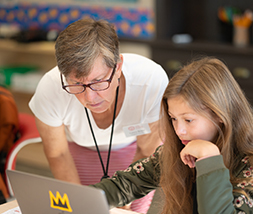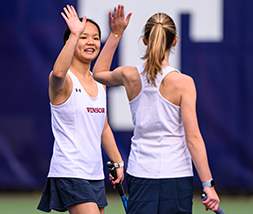Light in the Dark
If you have been lucky enough to come to campus over the past month, you will likely have seen the lights. Starting right around Diwali and continuing up to March break, the trees and columns along the front of the school, the maples along the Riverway, and the interior railings and courtyard trees are outlined in white lights—a bright and cheerful response to the darkest days of the year. The lights seem to invite the sunset, to proclaim that in fact the night has its own beauty and can uplift our gray winter world in a way that daytime cannot. It’s easy to revel in the natural world in the warmer months, when there are leaves and flowers and birds everywhere; it can be harder, but no less awe-inspiring, to take the time to admire this strange, pre-snow winter world.
There is something about this time of winter—the flat sky, the shockingly early sunset, the starkness of the trees and the buildings—of course we want to invite light into this strange space! At school, we have uplifting moments of all kinds happening: our pre-Thanksgiving Grandfriends Day, winter musical and dance concerts, games and rehearsals, special lunchtime soups, and a calendar countdown from the seniors with Snoopy dancing his way toward winter break. Maybe we are trying to cover up or ignore the darkness and the gray. But it has its own beauty.
I grew up in New England with a mother who loved nature, animals, and all things wild. One morning, seeing a pileated woodpecker in the backyard, she let us go to school late just so we could birdwatch. Kittens being born warranted an entire day off from school, as did the first day each spring when visitors could see the baby pigs on UConn’s campus. She talked about our backyard lilacs and the rhododendrons as if they were sentient. To this day, I am overjoyed at the arrival of the cardinals to our bird feeder; they bring a special flash of red against the brown backdrop. Sometimes a hawk will show up, and my husband and I debate: Cooper’s or Sharp-shinned? (Sharp-shinned, apparently.) Or to see the one stubborn rose, a drop of pink in the garden, which then has me looking at the vines, how they settle down into the mulch and wait for springtime, how the dried leaves hold their shape for longer than seems possible, how the ground beneath the bird feeder has been exposed by the sparrows picking through the fallen seeds, how our house cat sits in his chair on the back deck, watching this spare, cold world as if there is nothing else he would rather do.
This is the time of year when magic is harder to identify. We, in turn, string up lights, make hot cocoa, build a fire, settle in with a good book. We find warmth and light to shore us up through the long winter, and we know—of course we do—that the earth will continue to shift, that the sun will come back to us, and that we will find ourselves in summer once again before too long.
But let’s not simply bury ourselves in blankets and wait for winter to pass. The lights we see outside our windows can remind us that we all have such light within us as well. This is the time of year that calls on us to see it again, and to see it in others as well. This is the time of year we get to renew ourselves, our families, and our communities, to celebrate one another and our time together, to delight in each other, despite the cold, despite the dark.
As I write this, the hawks circle the Winsor courtyard, graceful and strong, as if guarding us. The sun is sinking behind the buildings, the students are heading out to sports and play rehearsals, and the classrooms are quiet for a few hours. Amidst all the bustle, the Winsor lights shine.





